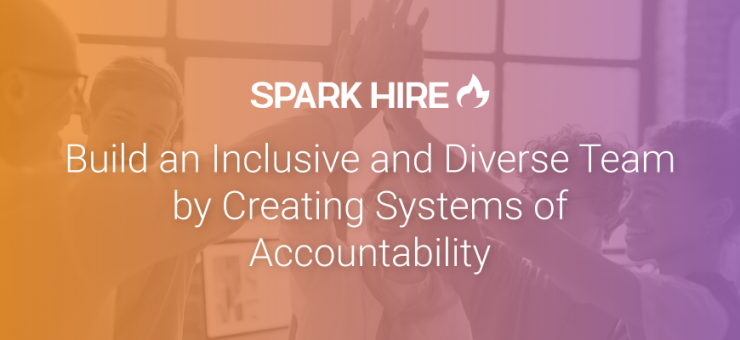Diversity in the workplace benefits everyone in the organization. It can increase productivity, employee retention, customer satisfaction, and even financial performance.
It’s no surprise diverse company populations lead to new ideas and innovations. Each person brings their own story and background to the work, allowing them to approach it uniquely. This builds empathy with their co-workers as well as the customers they serve. Empathy leads to stronger relationships and, ultimately, results.
But how do you build better diversity in the workplace? By creating a system of accountability.
You start by reflecting on current processes and evaluating gaps. Your team needs to have a clear process with well-defined expectations for hiring for diversity in the workplace. This means they must know each step, the requirements, and existing accountability checks.
Getting employee buy-in and investing in their understanding eliminates pushback. It also gives your team the opportunity to celebrate existing diversity. Keep your conversations about diversity open, and ensure your team feels comfortable talking about it. Create a common language within your organization with shared definitions.
Even if you have a solid system of diversity in place, there’s always room to improve. Constantly look for new voices to bring to the table and experts to invite to the work.
Here’s how to improve your system of accountability when establishing diversity in the workplace:
Dissect your data
Data is almost always the best place to start. Measuring diversity challenges you to take inventory of the team you have in place. Who is missing from the conversation? Improving diversity in the workplace requires you to take a look at all populations.
When you hear the word diversity, you likely think of underrepresented minorities, such as Black Americans, American Indians/Alaska Natives, and Latinx. But you should also think about equity among age groups, genders, education, and people with disabilities.
Get a pulse on your diversity hiring strategy by digging into some of the metrics below:
Branding – When looking at diversity in your branding, think of both awareness and impression. Who recognizes your brand and what impression do they have of your product and company? Does your brand resonate with minority populations? Are you including diverse faces and representation in your advertising?
College hires vs. Experience Hires – What percentage of your hires are college graduates? What percentage of those folks are from underrepresented groups? What percentage of your workforce has experience over degrees?
Interns – What percentage of interns are from underrepresented groups or minorities? What is their satisfaction with the company? What is their experience? Are certain groups interning with specific teams more than others?
Sourcing – Where are your applicants coming from? Where are your openings advertised? Are your open positions reaching diverse groups of individuals? Are you only hiring referrals from your current employees? Are there certain trends in this applicant pool?
Promotions – What is the comparative rate of promotion of minority employees? What length of time do they stay in positions before being eligible for promotions? Are there equity growth paths across departments and positions?
Management – Take a look at your leadership team. What percentage of managers identify as minorities? Repeat the exercise up the organizational ladder until you reach C-suite. How diverse is the team making decisions?
Data from these metrics should be readily available to everyone on the team. They should also be able to understand what it means. Building a culture where everyone is on the same page takes work, but the payoff is well worth it. When everyone understands the destination, the journey becomes collaborative.
Critically review the hiring steps
Implicit biases can pop up in job requirements, job description language, and even the posting source. These barriers may discourage minority candidates from even applying. Worse yet, they might not ever see the job post
Be brutal in your review. Uncover areas where you may be accidentally decreasing the effectiveness of your diversity hiring efforts.
Language can prematurely eliminate candidates by appealing to certain groups and alienating others. Write job descriptions in plain language. Carefully think about what you need this new hire to actually do to be successful in the role. Eliminate extra noise that inadvertently detours some populations. Be inclusive in your wording.
Make sure your job post can be seen by the masses, not just close connections. Having your employees post on their personal LinkedIn pages is a great start, but it’s not enough. Make sure your job post is on diverse sites so it can reach the broadest audience possible.
You also need to make the application process inclusive and inviting. Like the job posting, don’t overcomplicate the process or create extra hoops. You’ll get the most diverse pool of resumes as a result.
Finally, ensure you’re actually seeing all of the qualified applicants. Does your Applicant Tracking System (ATS) filter out certain minorities or groups at a higher rate? Identify why! Evaluate your filters to eliminate unqualified candidates without excluding talent you should at least meet.
Also, take a look at your interview process and the questions you ask.
- Do your interview questions create an inclusive work environment?
- Are there barriers to specific groups of candidates?
- How does the format (including virtual, in-person, etc.) give certain folks an advantage over others?
Examine who receives job offers most often and compare the offers extended. For example, objectively determine if women are getting the same offers as equally-qualified men. At what rate do women reject your offers versus men? Then do the same analysis with other minorities.
It’s important to look at what criteria are used to measure success during interviews. Identify whether specific underrepresented or minority groups are more inclined to be eliminated and at what step in the process. Look for patterns in what types of candidates make it through the interview process most frequently. Use this information to uncover unconscious (or conscious) biases that exist on the team.
Make this evaluation a learning opportunity for employees. Give everyone the chance to examine their personal beliefs. More importantly, work through misconceptions about diversity and inclusion with them and make changes where needed.
Put decision-makers under the scope
Take a hard look at how final decisions are made and who is making them. No one is exempt from the new system of accountability. You might face more resistance the higher up you go, but this work is important. You need your leadership team to model the company’s stance on diversity in the workplace.
Invite managers, directors, and C-suite members to participate in the conversation and ask questions without judgment. Allow this time to be educational rather than confrontational. Even leaders need tools to examine and overcome implicit biases. Have research available to support why diversity in the workplace is beneficial and what barriers you’ve uncovered in your organization so far.
To effectively improve diversity in the workplace, it’s critical you ensure accountability is present at all levels. Don’t back down. This is a company-wide initiative.
Throw out your old system
Just do it. If by this point you realize your old system doesn’t work, don’t try to patch it up. Work with your team to set new goals to give everyone the support and resources they need to be successful. Remember this is a journey to get everyone on the same page.
Tackle issues around diversity when they pop up. Don’t wait to see if they will resolve themselves. Be aggressively-supportive and empathetic as team members adjust to new processes. Work to educate everyone, and be patient with the learning curve.
Some team members will be reluctant to make changes. Be prepared to embrace them with understanding but firmness. Make your enthusiasm contagious, and rally everyone around the new systems. Most importantly, consistently reinforce the motivation behind these changes. Be transparent with your why and how everyone will be held accountable.
Set new goals and requirements
From recruiting through onboarding, set goals for increasing diversity in the workplace. Ensure that all populations and demographics have the opportunity to get in front of interviewers. Don’t be afraid to ditch “tried-and-true requirements” and archaic hiring rules. New goals require new rules and new tactics to succeed.
Re-examine and reframe the requirements you have in place for hiring. Think about what would be most valuable: college requirements or real-life experience? Does a 4-year degree actually translate into the skills you need? Not everyone can afford college or advanced degrees. You open up your talent pool when you consider work experience instead.
While shifting mindsets, take a minute to evaluate perceptions around job-hopping. Historically, people stayed with organizations, sometimes in the same positions, for their entire careers. Now, it’s more common for people to change jobs or industries as they advance toward their goals.
Don’t write this off as a weakness. Instead, look for the benefits of hiring someone who continually grows and changes. Job hoppers often bring invaluable qualities to the table due to their agility and creativity acquired along the way.
Look for candidates who add something new to your team dynamic. Seek those who bring unique culture to your organization versus someone who just fits into the current employee mold. People do better when those around us think differently and challenge us to be creative. In short, look for cultural add instead of just cultural fit.
Create a system for ongoing education. Stay committed to growth and development. Don’t let diversity in the workplace be a passing fad. Keep diversity top of mind by continuing to offer resources, workshops, and support. Make sure your data is updated, and work to improve your metrics.
And don’t forget to keep a pulse on your team. Continue to incorporate new ideas and voices as you strive to build a better and more diverse future for your brand.












